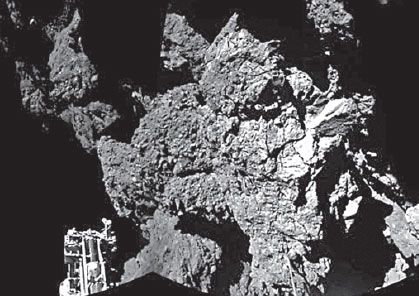Cosmic first as spacecraft lands on comet
Landing with a bounce after traveling 6.4 billion km, a European spacecraft made history on Wednesday by successfully reaching the icy, dusty surface of a speeding comet - a cosmic first designed to answer big questions about the universe.
The landing by the washing machine-sized craft after a decadelong journey required immense precision, as even the slightest error could have resulted in serious stellar calamity.
Indications were that the spacecraft touched down almost perfectly, save for an unplanned bounce, said Stephan Ulamec, head of the lander operation.
"Today we didn't just land once. We maybe even landed twice," he said with a chuckle.
Ulamec said thrusters that were meant to push the lander, called Philae, onto the surface, and harpoons that would have anchored it to the comet failed to deploy properly. Initial data from the spacecraft indicated that it lifted off again, turned and then came to rest.
Scientists were still trying to fully understand what happened and whether those failures would affect the lander's ability to remain on the comet, called 67P/Churyumov-Gerasimenko. But so far, most of the instruments were working and sending back data as hoped, Ulamec said.
"Tomorrow morning we should know a lot more," he said.
The landing team at mission control in Darmstadt had to sit through a tense seven-hour wait that began when Philae dropped from the agency's Rosetta space probe as both it and the comet hurtled through space at 66,000 kph.
During the lander's descent, scientists were powerless to do anything but watch, because its vast distance from Earth - more than 482 million km - made it impossible to send instructions in real time.
Finally, the agency received a signal that the lander had touched down.
While it may take a while to determine the exact state of the 100-kilogram lander, the fact that it was resting on the surface of the comet was already a huge success - the highlight of Rosetta's decadelong mission to study comets and learn more about the origins of these celestial bodies.
The head of the European Space Agency underlined Europe's pride at having achieved a unique first ahead of its US counterpart, NASA.
"We are the first to have done that, and that will stay forever," said the European agency's director-general, Jean-Jacques Dordain.
NASA contributed three instruments to the mission, and its Deep Space Network of giant radio antennas has been key to communicating with Rosetta.
Eight-time spacewalking astronaut John Grunsfeld, now associate administrator for science at NASA, called the landing "a breakthrough moment in the exploration of our solar system and a milestone for international cooperation".
"The data collected by Rosetta will provide the scientific community, and the world, with a treasure-trove of data," he said.
Scientists have likened the trillion or so comets in our solar system to time capsules that are virtually unchanged since the earliest moments of the universe.
Mark McCaughrean, a senior scientific adviser to the mission, said, "By studying one in enormous detail, we can hope to unlock the puzzle of all of the others."
|
The Philae probe is seen after it landed safely on a comet, known as 67P/Churyumov-Gerasimenko, in this image released on Thursday. Esa / Rosetta / Philae / Civa VIA Reuters |
(China Daily 11/14/2014 page10)















